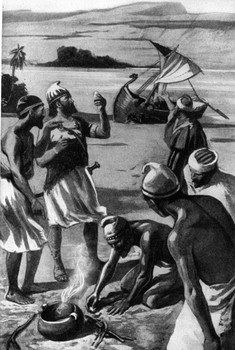An Introduction to the Ancient Middle East
Part 3: Phoenicians and Hebrews About 1200 B.C. a seafaring civilization arose along the Mediterranean Sea. These were the Phoenicians, and their boats carried traders and explorers alike. They carried customs and goods from one ancient civilizations to another. They are known for their alphabet, their papermaking, and their glassmaking. To the south of Phoenician
territory was Canaan,
a mountain-and-desert land that was home to the
Hebrews.
Abraham
led his people from the city of Ur
to Canaan about 1900 B.C. The Hebrews, who had started out
as traders, became growers of wheat, fig, and olives and
tenders of sheep. They stayed in Canaan for about 100 years,
during which time they organized themselves into the famous
12 Tribes. About 1800 B.C., a drought began, forcing the
Hebrews to move to Egypt.
The Hebrews elected
Saul
as their first king, and he ruled for several years. His
death brought David
to the throne. David continued Saul's campaigns against the
neighboring lands and made Jerusalem
his capital. His son, Solomon,
ruled for many years; when he died, the Hebrews split into
two kingdoms: Israel
in the north and Judah
in the south.
Next
page > Assyrians
and Chaldeans
> Page 1,
2,
3, 4,
5
|
|
Social Studies for Kids
copyright 2002–2025
David White



 The
Phoenicians founded cities (among them
The
Phoenicians founded cities (among them  Six
hundred years later, the Hebrews were enslaved in Egypt.
After a time,
Six
hundred years later, the Hebrews were enslaved in Egypt.
After a time, 
